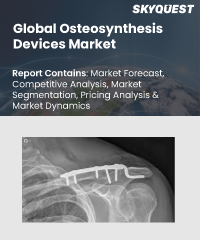
Report ID: SQMIG20C2063
Skyquest Technology's expert advisors have carried out comprehensive research on the osteosynthesis devices market to identify the major global and regional market trends and growth opportunities for leading players and new entrants in this market. The analysis is based on in-depth primary and secondary research to understand the major market drivers and restraints shaping the future development and growth of the industry.
Growing Aging Population
Increasing Trauma and Fracture Incidences
Rising Orthopedic Surgeries
High Cost
Complications and Infections
Regulatory Challenges
REQUEST FOR SAMPLE
Osteosynthesis Devices Market size was valued at USD 9.97 Billion in 2023 and is poised to grow from USD 10.77 Billion in 2024 to USD 19.93 Billion by 2032, growing at a CAGR of 8% during the forecast period (2025-2032).
The fierce competition in the global osteosynthesis devices market is characterized by major competitors competing to gain market share through cutting-edge products and calculated business tactics. Industry giants such as Stryker Corporation, DePuy Synthes (a Johnson & Johnson subsidiary), Zimmer Biomet Holdings, and Smith & Nephew, among others, compete for supremacy by utilizing their well-known brand reputations, extensive product portfolios, and international distribution networks. These key players continuously invest in research and development to introduce cutting-edge osteosynthesis solutions that cater to evolving patient needs. 'Stryker (United States)', 'Exactech (United States)', 'Medtronic (Ireland)', 'JRI Orthopaedics (United States)', 'FH Orthopedics (United States)', 'Globus Medical (United States)', 'RTI Surgical (United States)', 'NuVasive (United States)', 'MIS Implants Technologies (Switzerland)', 'KLS Martin (Germany)', 'Ortho Solutions (United States)', 'DePuy Synthes (United States)', 'Smith & Nephew (United Kingdom)', 'Alphatec Spine (United States)', 'Zimmer Biomet (United States)', 'Orthofix International (United States)', 'B. Braun Melsungen AG (Germany)', 'Aap Implantate (Germany)', 'Wright Medical Group (United States)', 'Bioventus (United States)'
The global aging population is a significant driver, as elderly individuals are more prone to fractures and orthopedic issues. The rising prevalence of osteoporosis and age-related conditions fuels the demand for osteosynthesis devices.
Personalized Medicine: The demand for customized implants and patient-specific therapies is rising. As a result of breakthroughs in imaging technology and 3D printing, it is now possible to produce patient-specific osteosynthesis devices that are compatible with each patient's anatomy which improves the results after the treatment.
As of 2022, North America held the dominant position in the global osteosynthesis devices market, holding the largest market share at 52.6% of the revenue. The region’s market supremacy can be credited to a number of factors that have changed the terrain of the orthopedic scene. Noteworthy among these factors are the concerted efforts of governments, the continuous release of new products, and robust investments in research and development. The buoyant healthcare expenditure within the region further propels its leadership status. Notably, the United States stands as a pivotal driver within North America due to its remarkable concentration of the major orthopedic device market. This concentration, predominantly in the U.S., positions it as not only the most financially rewarding but also the largest market for osteosynthesis equipment, securing a staggering 90% or more of the market share in the region.
Want to customize this report? This report can be personalized according to your needs. Our analysts and industry experts will work directly with you to understand your requirements and provide you with customized data in a short amount of time. We offer $1000 worth of FREE customization at the time of purchase.
Feedback From Our Clients

Report ID: SQMIG20C2063
sales@skyquestt.com
USA +1 351-333-4748